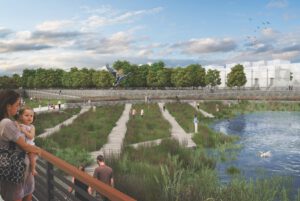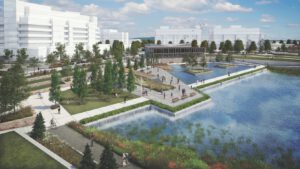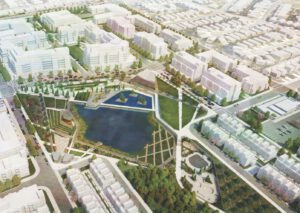HDR, Inc., recently designed the Historic Fourth Ward Park in Atlanta, Georgia—a popular community gathering space that can also capture nearly 7 million gallons of storm water runoff, thus forming an important part of Atlanta’s water infrastructure. Word about the innovative park design spread all the way to Calgary, Alberta, where a local developer contacted HDR to ask for its help in creating a similar feature in a mixed-use development near the downtown area. In this interview with Municipal Water Leader writer Tyler Young, Robby Bryant, HDR’s planning and landscape architecture discipline leader, tells us about how he brought the lessons of the Fourth Ward Park northward, and adapted them for the needs and climate of his client in Calgary.
 Tyler Young: Please tell us about West District Central Park.
Tyler Young: Please tell us about West District Central Park.
Robby Bryant: West District Central Park is a planned urban park in west Calgary that marries public open space with storm water management to create a recreational destination for the surrounding community. The park is located within West District, an 84-acre master-planned development that is envisioned as a high-density, mixed-use, compact, and transit-supportive neighborhood. HDR collaborated with developer Truman Development Corporation, CivicWorks Planning + Design, Urban Systems, S2 Architecture, and the City of Calgary to plan and design the park to be the heart and centerpiece of the development’s urban center. Principles of resiliency helped guide the design, which resulted in active park spaces that are rarely affected by storm events.
The 8-acre park is organized around a central lake that provides storm water storage for the West District development. Fountains, boardwalks, overlooks, and plantings transform the lake from storm water infrastructure to an impressive park centerpiece. Program elements, such as a wintertime ice rink, a performance venue, and a restaurant, were given prominent placement in the park design to help provide activities for all seasons and make it a year-round destination.
Tyler Young: What are some of the lessons that you are applying to this park?
 Robby Bryant: Long-term maintenance is always a concern when designing storm water parks. One way to minimize maintenance efforts is to limit or carefully select the program elements that are placed within the inundation zone. Walkways, boardwalks, and hardscape elements are resilient and may not require additional attention following storm events; however, certain plantings, walls, water features, lawn spaces, and playgrounds may require extra resources or time to clean up.
Robby Bryant: Long-term maintenance is always a concern when designing storm water parks. One way to minimize maintenance efforts is to limit or carefully select the program elements that are placed within the inundation zone. Walkways, boardwalks, and hardscape elements are resilient and may not require additional attention following storm events; however, certain plantings, walls, water features, lawn spaces, and playgrounds may require extra resources or time to clean up.
Another aspect of maintenance is understanding which personnel will be responsible for maintaining the facility following completion. In most cases, maintenance tasks are
shared between Water Resources and the Parks Department. It is important to design a facility that allows existing staff to perform familiar maintenance activities using proven techniques. Providing a maintenance schedule with a list of seasonal tasks is critically necessary for the long-term success of the park.
Tyler Young: How do you see the park developing, and what is the general outlook for it?
Robby Bryant: West District Central Park will provide an unprecedented impact in implementing the Calgary City Council’s Smart Growth goals. As part of the planned urban center, the park design is forward thinking and multifunctional, integrating people spaces with storm water management and natural landscape. The result is a seamlessly integrated park and storm water management facility that provides a unique and dynamic public open space within the vibrant West District urban development.
 Tyler Young: Could you tell us a little bit about yourself and how you became involved with HDR?
Tyler Young: Could you tell us a little bit about yourself and how you became involved with HDR?
Robby Bryant: My first job after school was for a local architecture firm in Atlanta. Most of the work we did back then included park and trail design in small towns throughout Georgia. About 15 years ago, I joined HDR and was brought in on some larger-scale projects throughout the Southeast and Midwest.
Working for a larger company provides unique opportunities to explore and make use of the vast amount of available resources. It wasn’t long before our team of landscape architects was collaborating with environmental engineers and water resources staff on green infrastructure work in parks. We have continued to leverage opportunities by working with other experts within the company; this has opened doors for our efforts on several integrated, multi-functional projects.
Tyler Young: Do you have any words of wisdom to those in the industry?
Robby Bryant: One thing that we try to encourage on our projects is cross-discipline collaboration. It is important to understand the different priorities that each team member values for success of the project. Understanding these issues leads to creative design solutions that bring multiple benefits.
Robby Bryant is the planning and landscape architecture discipline leader for HDR. He can be reached at robby.bryant@hdrinc.com.
